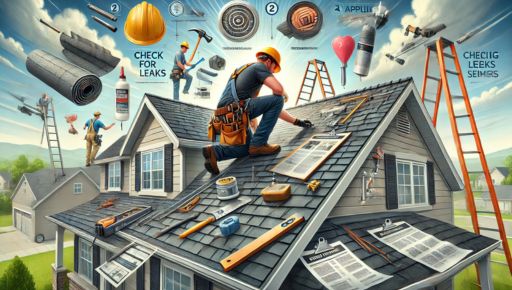Your roof is a crucial component of your home’s structure, providing protection against the elements and enhancing your home’s overall energy efficiency. However, like any other part of your house, it can encounter problems over time. Identifying and addressing roofing issues promptly can prevent more extensive damage and costly repairs. Here’s a comprehensive guide to some common roofing problems and how to fix them.
1. Leaks and Water Damage
Problem: Roof leaks are among the most common issues homeowners face. Leaks can result from damaged shingles, poor flashing, or clogged gutters. Water damage can lead to mold growth, structural issues, and interior damage.
Solution: To fix a leak, start by locating the source. Inspect the roof for damaged or missing shingles, damaged flashing, or areas where water might be seeping through. For shingle damage, replace the affected shingles by removing the old ones and securing new ones in place. If flashing is damaged, reseal or replace it. For clogged gutters, clean them regularly to ensure proper water flow.
2. Missing or Damaged Shingles
Problem: Shingles can become damaged or go missing due to harsh weather conditions, age, or poor installation. Missing or damaged shingles can compromise the roof’s integrity and lead to leaks.
Solution: Inspect your roof periodically for missing or damaged shingles. To replace them, remove the damaged shingles carefully, lift the surrounding shingles, and slide the new ones into place. Secure them with roofing nails and apply roofing cement to seal any gaps.
3. Granule Loss
Problem: Asphalt shingles have a protective layer of granules that can wear off over time due to weather exposure. Granule loss can reduce the effectiveness of your shingles and lead to premature aging.
Solution: If you notice a significant loss of granules, it may be time to replace your shingles. While minor granule loss is normal with age, extensive loss could indicate that your shingles are nearing the end of their lifespan. Consider consulting a roofing professional to assess the condition of your roof and recommend appropriate actions.
4. Cracked or Buckled Shingles
Problem: Cracked or buckled shingles can occur due to extreme temperatures, improper installation, or aging. These issues can lead to water infiltration and reduced roof performance.
Solution: Replace cracked or buckled shingles to prevent further damage. To fix them, remove the damaged shingles and install new ones, ensuring they are properly aligned and secured. Additionally, ensure that your roof is ventilated properly to prevent heat buildup that can cause shingle buckling.
5. Flashing Issues
Problem: Flashing is used around roof penetrations, such as chimneys, vents, and skylights, to prevent water from entering the home. Damaged or improperly installed flashing can lead to leaks and water damage.
Solution: Inspect the flashing around these areas regularly. If you find damage, such as rust or gaps, repair or replace the flashing as needed. You may need to remove and replace the surrounding shingles to properly install new flashing. For a more permanent solution, consider using a high-quality roofing sealant to seal any gaps.
6. Roof Ventilation Problems
Problem: Proper ventilation is essential for maintaining your roof’s health and energy efficiency. Poor ventilation can lead to excessive heat buildup, which can damage shingles and underlayment.
Solution: Ensure that your roof has adequate ventilation by checking the intake and exhaust vents. Clean out any debris that might be obstructing airflow. If necessary, install additional vents or upgrade existing ones to improve air circulation. Proper ventilation helps extend the lifespan of your roof and improves indoor comfort.
7. Gutter Issues
Problem: Gutters play a crucial role in directing water away from your roof and foundation. Clogged or damaged gutters can cause water to pool on the roof, leading to leaks and structural damage.
Solution: Regularly clean your gutters and downspouts to prevent clogs. Inspect for damage, such as holes or sagging, and repair or replace any damaged sections. Ensure that gutters are properly aligned to direct water away from the roof and foundation effectively.
8. Ice Dams
Problem: Ice dams form when snow on the roof melts and refreezes at the eaves, causing water to back up under the shingles. This can lead to leaks and water damage inside your home.
Solution: Prevent ice dams by ensuring proper attic insulation and ventilation to keep the roof surface cold. Remove snow from the roof using a roof rake, especially near the eaves. Installing heated cables along the eaves can also help prevent ice dam formation.
9. Roof Sagging
Problem: Roof sagging can indicate structural issues, such as compromised rafters or trusses. It may also be a sign of excessive moisture or poor installation.
Solution: If you notice any sagging areas, consult a roofing professional immediately. They will assess the structural integrity of your roof and recommend necessary repairs. In some cases, it may be necessary to reinforce or replace damaged structural components.
10. Punctures and Holes
Problem: Punctures and holes can be caused by falling debris, animal activity, or improper installation. These can lead to leaks and further damage if not addressed promptly.
Solution: For small punctures or holes, apply a roofing patch or sealant to cover the affected area. For larger holes or significant damage, replace the damaged section of the roof. Ensure that the patch or replacement materials are compatible with your existing roofing to maintain a watertight seal.
Final Thoughts
Regular maintenance and timely repairs are essential for extending the lifespan of your roof and preventing more significant issues. By being proactive and addressing common roofing problems promptly, you can protect your home and ensure its long-term durability. If you’re unsure about how to handle a roofing issue, don’t hesitate to consult with a professional roofing contractor to get expert advice and quality repairs.
For more tips on home maintenance and roofing care, stay tuned to our blog and follow us on social media for updates and expert advice.



